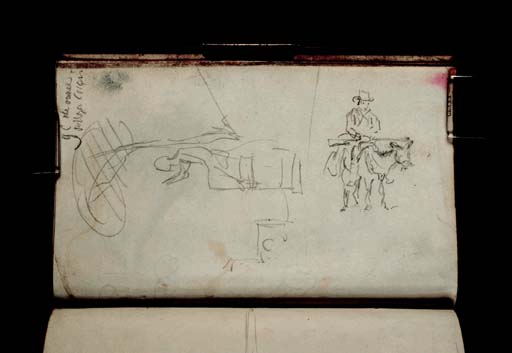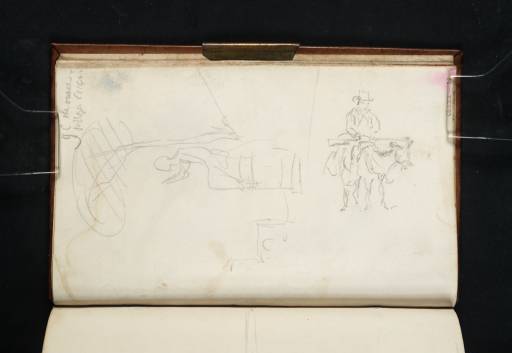Joseph Mallord William Turner The Vicolo Sterrata, Rome, with the Statue of Apollo in the gardens of the Palazzo Barberini; also a Man on a Donkey 1819
Image 1 of 2
-
 Joseph Mallord William Turner, The Vicolo Sterrata, Rome, with the Statue of Apollo in the gardens of the Palazzo Barberini; also a Man on a Donkey 1819
Joseph Mallord William Turner, The Vicolo Sterrata, Rome, with the Statue of Apollo in the gardens of the Palazzo Barberini; also a Man on a Donkey 1819 -
 Joseph Mallord William Turner, The Vicolo Sterrata, Rome, with the Statue of Apollo in the gardens of the Palazzo Barberini; also a Man on a Donkey 1819 (Enhanced image)Enhanced image
Joseph Mallord William Turner, The Vicolo Sterrata, Rome, with the Statue of Apollo in the gardens of the Palazzo Barberini; also a Man on a Donkey 1819 (Enhanced image)Enhanced image
Joseph Mallord William Turner,
The Vicolo Sterrata, Rome, with the Statue of Apollo in the gardens of the Palazzo Barberini; also a Man on a Donkey
1819
Joseph Mallord William Turner 1775–1851
Folio 80 Recto:
The Vicolo Sterrata, Rome, with the Statue of Apollo in the gardens of the Palazzo Barberini; also a Man on a Donkey 1819
D15245
Turner Bequest CLXXX 79
Turner Bequest CLXXX 79
Pencil on white wove paper, 161 x 101 mm
Inscribed by the artist in pencil ‘9 C the ounce | Pallaza Corsini’ top right
Inscribed by John Ruskin in red ink ‘79’ bottom right
Stamped in black ‘CLXXX 79’ bottom right
Inscribed by John Ruskin in red ink ‘79’ bottom right
Stamped in black ‘CLXXX 79’ bottom right
Accepted by the nation as part of the Turner Bequest 1856
References
1909
A.J. Finberg, A Complete Inventory of the Drawings of the Turner Bequest, London 1909, vol.I, p.534, as ‘Traveller on a donkey; also statue in a garden or courtyard. “9c the ounce, Pallaza Corsini (?)” ’.
The subject of the main sketch on this page is the Vicolo Sterrata, a rustic looking street which once ran behind the gardens of the Palazzo Barberini and is today the via Barberini. In his book Walks in Rome, Augustus J.C. Hare recalled this celebrated picturesque corner of the city:
Till late years, there was a pretty old-fashioned garden belonging to this [Barberini] palace, at one corner of which – overhanging an old statue – stood the celebrated Barberini Pine, often drawn by artists from the Via Sterrata at the back of the garden, where statue and pine combined well with the Church of S. Caio; but, alas! this magnificent tree was cut down in 1872, and the church has since been destroyed.1
As Hare notes, the motif of the large stone pine and the adjacent statue of the Apollo Citerado (i.e. playing the cithara) offered an attractive proposition for artists and the spot was painted by a number of nineteenth-century painters including Jean-Baptiste-Camille Corot (1796–1875), Ettore Roesler Franz (1845–1907),2 and the Danish artist, Constantin Hansen (1804–1880).3 The statue can still be found within the grounds of the palace but now stands in a niche at the back of the gardens. A further sketch can be found in the Albano, Nemi, Rome sketchbook (see Tate D15430; Turner Bequest CLXXXII 69a).
Also on this page is a swift study drawn from life of a man on a donkey, holding a large whip or staff. Turner has executed the sketch parallel with the bottom of the page. Further sketches of people can be found on the inner front cover and on folios 6 verso, 14 verso, 15 verso, 33 verso, 64, 69, 80 verso, 82 and 82 verso (D40619, D15114, D15130, D15132, D15167, D15223, D15228, D15246, D15249 and D15250; Turner Bequest CLXXX 5a, 13a, 14a, 32a, 63, 68, 79a, 81 and 81a).
Nicola Moorby
December 2009
How to cite
Nicola Moorby, ‘The Vicolo Sterrata, Rome, with the Statue of Apollo in the gardens of the Palazzo Barberini; also a Man on a Donkey 1819 by Joseph Mallord William Turner’, catalogue entry, December 2009, in David Blayney Brown (ed.), J.M.W. Turner: Sketchbooks, Drawings and Watercolours, Tate Research Publication, December 2012, https://www

